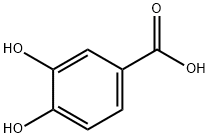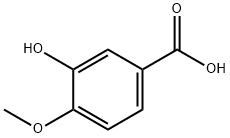3,4-Dihydroxybenzaldehyde , 96% , 139-85-5
Synonym(s):
3,4-Dihydroxybenzaldehyde;Protocatechualdehyde
CAS NO.:139-85-5
Empirical Formula: C7H6O3
Molecular Weight: 138.12
MDL number: MFCD00003370
EINECS: 205-377-7
| Pack Size | Price | Stock | Quantity |
| 25G | RMB63.20 | In Stock |
|
| 100G | RMB215.20 | In Stock |
|
| 500G | RMB799.20 | In Stock |
|
| others | Enquire |
PRODUCT Properties
| Melting point: | 150-157 °C(lit.) |
| Boiling point: | 213.5°C (rough estimate) |
| Density | 1.2667 (rough estimate) |
| refractive index | 1.4600 (estimate) |
| storage temp. | Store below +30°C. |
| solubility | 6.3g/l |
| form | Crystalline Powder |
| pka | pK (25°) 7.55 |
| color | slightly brown |
| Odor | at 100.00 %. dry medicinal bitter almond |
| Odor Type | medicinal |
| Water Solubility | 50 g/L (20 ºC) |
| Sensitive | Air Sensitive |
| Merck | 14,7893 |
| BRN | 774381 |
| Stability: | Stable. Incompatible with strong bases, strong oxidizing agents. |
| LogP | 1.090 |
| CAS DataBase Reference | 139-85-5(CAS DataBase Reference) |
| NIST Chemistry Reference | 3,4-Dihydroxybenzaldehyde(139-85-5) |
| EPA Substance Registry System | Benzaldehyde, 3,4-dihydroxy- (139-85-5) |
Description and Uses
Protocatechualdehyde is extracted from roots of the common traditional Chinese medicine Salvia miltiorrhiza Bge, which was harvested in autumn for better quality. Take root and remove stems, leaves and fibrous roots, then dry it. Most of them are wide, and they are mainly cultivated in recent years. South Salvia and Gansu Salvia are also widely used. Besides, there are a variety of sibling plant roots used as Salvia miltiorrhiza in Yunnan. Now, the existence of protocatechualdehyde has been found in variety of herbs, for example, in the leaf of Stenoloma Chusanum (L.) Ching and Ilex chinensis Sims.
3,4-Dihydroxybenzaldehyde may be used for the surface modification of nanocrystalline TiO2 particles. Electrodeposited layer of 3,4-dihydroxybenzaldehyde may be used as effective redox mediator during oxidation of NADH at graphene. It may be used in the preparation of new diSchiff base ligands, which forms di-, tri- and tetranuclear Co(II) and Cu(II) complexes.
Safety
| Symbol(GHS) |  GHS07 |
| Signal word | Warning |
| Hazard statements | H315-H319-H335 |
| Precautionary statements | P261-P264-P271-P280-P302+P352-P305+P351+P338 |
| Hazard Codes | Xi |
| Risk Statements | 36/37/38-22 |
| Safety Statements | 26-36-37/39 |
| WGK Germany | 3 |
| RTECS | UL0380000 |
| F | 9 |
| Hazard Note | Irritant/Air Sensitive |
| HS Code | 29124900 |




